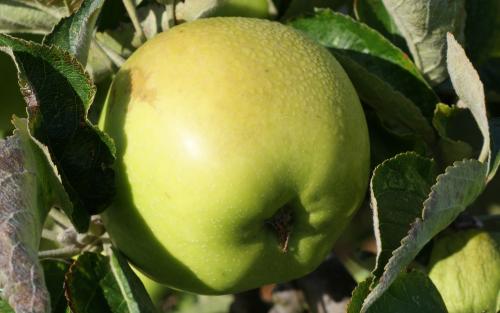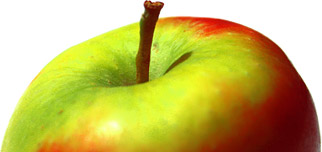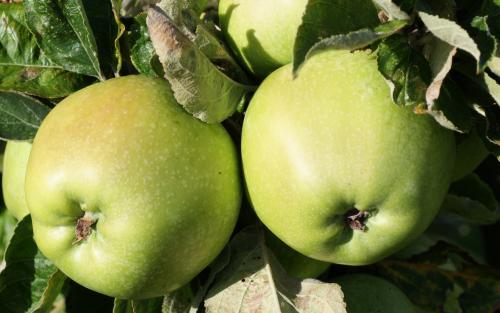
Lord Derby is a traditional large English cooking apple, ripening in the mid-season - early September. It remains a popular apple variety in English gardens, and is a good choice if you are looking for an apple tree for the garden as an alternative to Bramley which can be used in the period from September to November.
Lord Derby is quite easy to identify, on account of its large size, bright green colours and ribbed shape. The Victorian author Hogg rates it as an "excellent culinary apple". The flavour is nicely acidic if picked young, but milder if picked when fully ripe (at which point the skin develops a more yellow hue). Like many Victorian cooking apples, it has naturally good disease resistance.
Lord Derby apple identification images
All images copyright Orange Pippin unless otherwise stated.
USDA identification images for Lord Derby
The identification paintings in the USDA Pomological Watercolor Collection span the years 1886 to 1942.
Citation: U.S. Department of Agriculture Pomological Watercolor Collection. Rare and Special Collections, National Agricultural Library, Beltsville, MD 20705.
Parents and other ancestors of this variety
Visitor reviews
- 21 Aug 2022Definitely a cooker, and definitely not bland! Large apples that hug the branch and crop late. Skin turns very waxy over winter, and mine keep until at least February in a cool garage in the North of England.
- 01 Oct 2020 ABERDEENSHIRE, United KingdomAgree with the grower in Gloucestershire that this apple, though prolific, seems to be completely tasteless. Perhaps I am too far north for it to do well.
- 21 Sep 2016 BRIDGEND, WALES, United KingdomI've had a Lord Derby apple from a pup!!!!! Don't agree with the comments on taste. It is very good when baked, and used for apple tart. Because of the short keeping time I usually core peel chop and freeze it. However, I find that keeping some in the refrigerator helps to keep it longer.
- 16 Sep 2016 DORSET, United StatesWe inherited a large old tree 10 years ago which was identified as Lord Derby at an apple day in Cumbria. After 3 years of professional pruning it has proved well worth saving. Here it breaks down well on cooking and is very good in cakes. Brown rot and mice mean it only lasts until January. Mice leave alone any wrapped in news paper.
- 21 Oct 2012 CARMARTHENSHIRE, United KingdomA large old apple tree (70 to 80 years or more)in our garden has been identified at the Apple Day festival at the National Botanic Gardens of Wales as the variety 'Lord Derby'. It does cook very well and as long as plentty of sugar is added has good flavour when cooked. It also crops very well, and 2011 was an exceptionally bumper year, but even in this wet year we have had a reasoanble crop it usually stores for 3 to 4 months in the garden shed provided the mice don't cause too much damage. It does soon turn yellow but still seems OK when stewed.
- 27 Nov 2011 CHESHIRE, United KingdomI think this is the variety I have and I agree that it is quite a bland taste and doesn't fall well when cooked. However, it is a prolific fruiter and I have trained it to keep it compact. Going to use this year's crop with the addition of some Bramleys to make cider.
- 13 Nov 2010 GLOS., United KingdomWe inherited an apple that has been identified as Lord Derby and is certainly large and green, turnng yellowish when ripe. Unfortunately, we find it virtually tasteless whether raw or cooked, and it does not form any kind of puree when cooked, but remains in slices. Any suggestions?
Tree register
United Kingdom
- Alex in Scourie, SUTHERLAND
- Andrew Binnian in East Linton, EAST LOTHIAN
- Anthony Ryan in Cambridge, CAMBS
- Ben in Peterborough, LINCOLNSHIRE
- Brian Sharp in Burrelton, PERTHSHIRE
- Chris Kettlety in Macclesfield, CHESHIRE
- Clifford Cain in Doncaster, SOUTH YORKSHIRE
- Clifford Cain in Bawtry, Doncaster, SOUTH YORKSHIRE
- Connor in Southampton,
- Darren T in MANCHESTER, GREATER MANCHESTER
- Denise Casanova in Mildenhall, SUFFOLK
- Des Kelly in INVERNESS,
- Harry in Cobham, KENT
- Jane Gadsby in Chipping Campden, GLOUCESTERSHIRE
- Janet Coley in Bicester, OXFORDSHIRE
- Joe in PETER TAVY, DEVON
- Jonathan Gubb in Uffculme, DEVON
- Julie Quantrill in INVERURIE, ABERDEENSHIRE
- Karen Guthrie in Coniston, CUMBRIA
- Kate Bagenal-Lowe in Wooler, NORTHUMBERLAND
- Mark Davies in Saddleworth, YORKSHIRE
- Mary Fielding in LEDBURY, HEREFORDSHIRE
- Melanie Fuller in Harrogate, NORTH YORKSHIRE
- Mrs Diane Wilcox in STAFFORDSHIRE
- Nick Burrows in Helmsley, NORTH YORKSHIRE
- Nickkk in Oldham, LANCASHIRE
- Nigel in Ryton Dorrington Shrewsbury, SHROPSHIRE
- P Venner in WORTHING, WEST SUSSEX
- Paul Haines in Llandyfriog, Newcastle Emlyn, CEREDIGION
- Pauline Shannon in Biggar, SOUTH LANARKSHIRE
- Peter Samsom in Hexham, NORTHUMBERLAND
- Philip Wray in Andover, HAMPSHIRE
- Steve Sim in Grange Over Sands, CUMBRIA
- Sue Fawcett in Pocklington, York, YORKSHIRE
- Suzanne Iley in Birmingham, WEST MIDLANDS
- Tim Hucker in London,
Ireland
- Kevin Magee in Duleek, MEATH
Spring blossom records for this variety
2012 season
- 20th May 2012 - tree owned by Nickkk in Oldham, United Kingdom
2011 season
- 26th May 2011 - tree owned by Mrs Di in , United Kingdom
- May 2011 - tree owned by Philip in Andover, United Kingdom
2010 season
- 13th May 2010 - tree owned by Clifford in Doncaster, United Kingdom
2009 season
- 4th April 2009 - tree owned by Harry in Cobham, United Kingdom
Record your blossom dates in our Fruit Tree Register - more >>.
Harvest records for this variety
2016 season
- 3rd week October 2016 - tree owned by Nigel in Ryton Dorrington Shrewsbury, United Kingdom
2015 season
- 2nd week October 2015 - tree owned by Peter in Hexham, United Kingdom
2014 season
- 2nd week September 2014 - tree owned by Ben in Peterborough, United Kingdom
2011 season
- 2nd week November 2011 - tree owned by Mrs Di in , United Kingdom
- 1st week November 2011 - tree owned by Philip in Andover, United Kingdom
- 4th week August 2011 - tree owned by Anthony in Cambridge, United Kingdom
2010 season
- 1st week October 2010 - tree owned by Kevin in Duleek, Ireland
2009 season
- 2nd week September 2009 - tree owned by Harry in Cobham, United Kingdom
Origins
- Species: Malus domestica - Apple
- Originates from: Cheshire, United Kingdom
- Introduced: 19th century
- UK National Fruit Collection accession: 1978-300
Identification
- Country of origin: United Kingdom
- Period of origin: 1850 - 1899
- Leaf colour: Green
- Annual cycle: Deciduous
Using
- Picking season: Late
- Keeping (of fruit): 1-2 months
- Flavour quality: Very good
- Flavour style (apples): Sharper
- Cooking result: Textured puree
- Discoloration of fruit: Oxidising
- Cropping: Good
- Fruit persistence: Normal ripening
- Food uses: Culinary
- Food uses: Juice
- Food uses: Traditional cooker
- Picking period: early September
- Wildlife: RHS Plants for Pollinators
Growing
- Gardening skill: Beginner
- Flowering group: 4
- Pollinating others: Average
- Ploidy: Diploid
- Vigour: Vigorous
- Bearing regularity: Regular
- Fruit bearing: Spur-bearer
- Self-fertility: Not self-fertile
Climate
- Frost resistance of blossom: Good resistance
- Climate suitability: Temperate climates
- Climate suitability: Mild damp climates
- Summer average maximum temperatures: Cool ( 20-24C / 68-75F)
- Summer average maximum temperatures: Cold (< 20C / 67F)
Other qualities
- Disease resistance: Good
- Scab (Apple and Pear): Very resistant
- Brown rot: Very susceptible
Where to buy trees
The following tree nurseries offer Lord Derby apple trees for sale:
- Orange Pippin Fruit Trees (UK) United Kingdom
Lord Derby apple trees
Where to buy fresh fruit
The following orchards grow Lord Derby:
United Kingdom
England - north
- Coulton Mill, York
- Saddleworth Orchard, Saddleworth
England - south-east
- Wigmore Orchard, Tadley
England - south-west
- Charlton Orchards, Taunton
References
- Fruit Expert
Author: Hessayon


